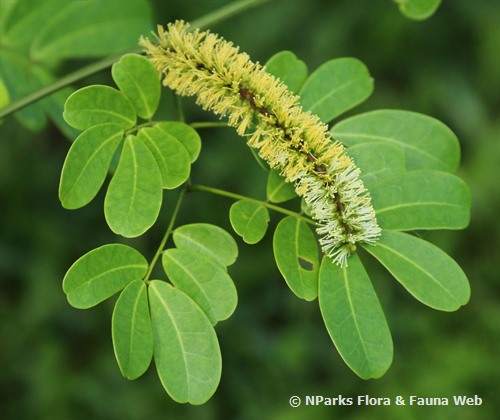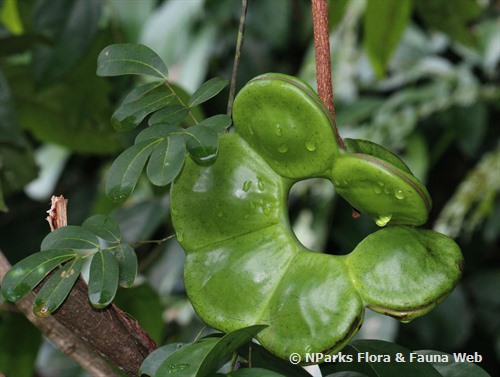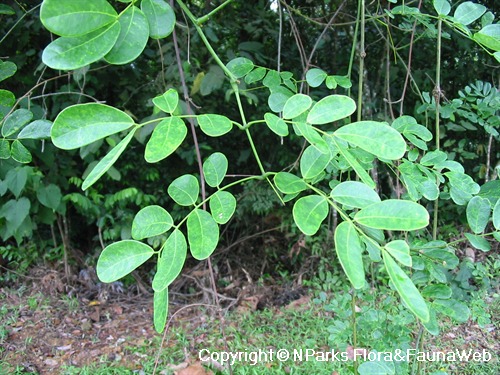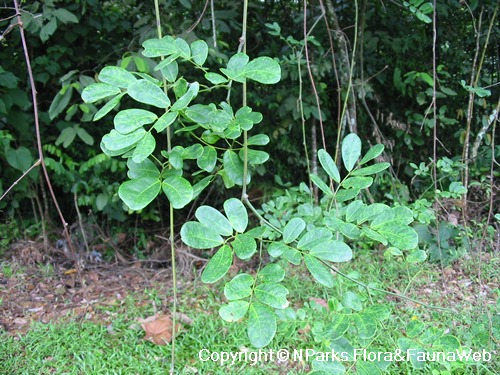
Name
Classifications and Characteristics
| Plant Division | Angiosperms (Flowering Seed Plants) (Dicotyledon) |
|---|---|
| Plant Growth Form | Climber |
| Lifespan (in Singapore) | Perennial |
| Mode of Nutrition | Autotrophic |
| Maximum Height | 25 m |
Biogeography
| Native Distribution | Thailand, Sumatra, Peninsular Malaysia, and Singapore |
|---|---|
| Native Habitat | Terrestrial (Primary Rainforest, Secondary Rainforest) |
| Preferred Climate Zone | Tropical |
| Local Conservation Status | Native to Singapore (Vulnerable (VU)) |
Description and Ethnobotany
| Growth Form | It is a woody climber up to 25 m long. |
|---|---|
| Foliage | Its leaves are bipinnate with up to 4 pairs of stalked secondary leaflets (pinnules) per primary leaflet (pinna). Its opposite pinnules have papery leaf blades that are elliptic to drop-shaped and 1.8–6.5 by 0.9–3 cm. The pinnule blade has a notched tip. |
| Flowers | Its solitary flowering spikes are 15–20 cm long and arise from the leaf axils. Its white flowers are 5-merous, and either male or bisexual. |
| Fruit | Its large, spirally coiled, woody pods (legumes) are 1.2–1.8 m by 6 cm. Its 6.5 cm long seeds are irregularly compressed by the pod segments. |
| Habitat | It grows at primary and secondary forests up to 540 m in altitude. |
| Associated Fauna | Its flowers are insect-pollinated. |
| Cultivation | It can be propagated by seed. |
| Etymology | Entada, a southern Indian name applied by van Rheede for the genus of plants that produces giant seeds that float across the Atlantic Ocean to reach northwest Europe; Latin spiralis, spiral, referring to the fruit’s shape |
| Ethnobotanical Uses | Others: Its bark and seeds contain saponin which can be used as a substitute for soap. |
Landscaping Features
| Landscaping | It may be suitable for parks and the vertical greening of buildings. |
|---|---|
| Desirable Plant Features | Ornamental Fruits |
| Landscape Uses | Parks & Gardens, Vertical Greenery / Green Wall, Trellis / Arbour / Pergola |
Fauna, Pollination and Dispersal
| Pollination Method(s) | Biotic (Fauna) |
|---|---|
| Seed or Spore Dispersal | Abiotic |
Plant Care and Propagation
| Light Preference | Semi-Shade, Full Sun |
|---|---|
| Water Preference | Little Water, Moderate Water |
| Plant Growth Rate | Moderate |
| Rootzone Tolerance | Moist Soils, Well-Drained Soils, Fertile Loamy Soils |
| Propagation Method | Seed |
Foliar
| Foliage Retention | Evergreen |
|---|---|
| Mature Foliage Colour(s) | Green |
| Mature Foliage Texture(s) | Papery |
| Foliar Type | Compound (Bipinnate) |
| Foliar Arrangement Along Stem | Alternate |
| Foliar Attachment to Stem | Petiolate |
| Foliar Shape(s) | Non-Palm Foliage (Obovate, Elliptical) |
| Foliar Venation | Pinnate / Net |
| Foliar Margin | Entire |
Floral (Angiosperm)
| Flower & Plant Sexuality | Unisexual & Bisexual Flowers(Sub-dioecious) |
| Flower Colour(s) | White |
|---|---|
| Flower Grouping | Cluster / Inflorescence |
| Flower Location | Axillary |
Fruit, Seed and Spore
| Mature Fruit Colour(s) | Brown |
|---|---|
| Fruit Classification | Simple Fruit |
| Fruit Type | Dehiscent Dry Fruit , Legume / Pod |
| Mature Seed Colour(s) | Black |
| Mature Seed Texture(s) | Glossy / Shiny |
Image Repository
Others
| Master ID | 93 |
|---|---|
| Species ID | 1389 |
| Flora Disclaimer | The information in this website has been compiled from reliable sources, such as reference works on medicinal plants. It is not a substitute for medical advice or treatment and NParks does not purport to provide any medical advice. Readers should always consult his/her physician before using or consuming a plant for medicinal purposes. |



